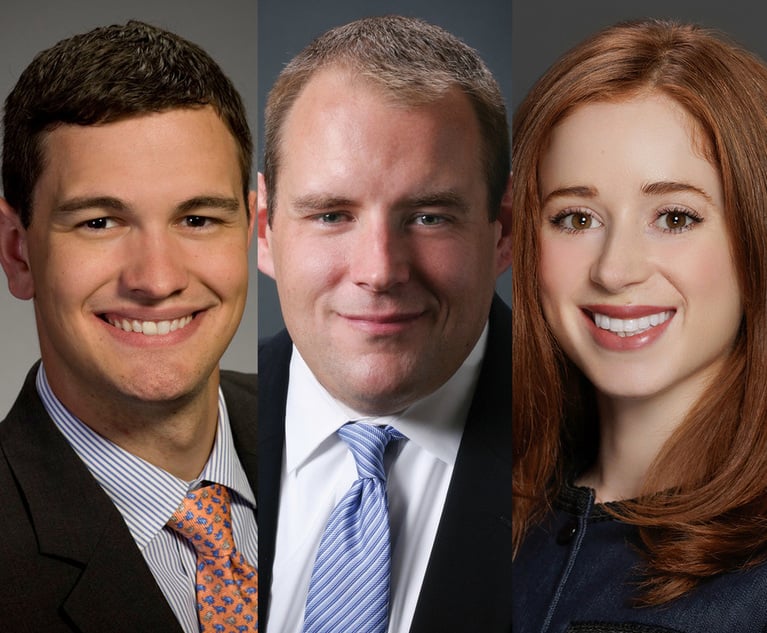The Big Oops: Planning for Inadvertent Disclosures of Trade Secrets
Fortunately, inadvertent disclosure of a trade secret does not mean that all is lost, provided that prompt and definitive action is taken.
April 03, 2019 at 12:29 PM
5 minute read
 Stephen Vaughn of Morris Manning & Martin (Courtesy photo)
Stephen Vaughn of Morris Manning & Martin (Courtesy photo)According to estimates, in 2018 the average business user sent and received 140 emails per day, a figure that is projected to grow significantly in coming years. On top of that, more business e-mail is done on mobile devices, which unfortunately means less attention to detail. As a result, we have seen increased incidence of company employees inadvertently sending sensitive corporate information to unintended recipients. And the risk emanates not only from your company's employees, but also the employees of any vendors who have access to your trade secrets. Fortunately, inadvertent disclosure of a trade secret does not mean that all is lost, provided that prompt and definitive action is taken.
Putting the Horse Back in the Barn
When it comes to the inadvertent disclosure of trade secrets, it can be possible to “put the horse back in the barn,” but notice of the disclosure must be given to the unintended recipient as soon as possible. Both the Uniform Trade Secret Act and the federal Defend Trade Secrets Act impose liability on those who use or disclose a trade secret with actual or constructive knowledge that it was “acquired by accident or mistake,” provided that such knowledge arose “before a material change of … position” by that person. Put another way, if the unintended recipient of a trade secret uses or discloses it without actual or constructive knowledge, no liability will exist. As a result, it is imperative that notice be given to the recipient promptly after learning of the inadvertent disclosure. Doing so will both 1) impose liability on the inadvertent recipient if they make use of disclosure, and 2) increase the odds that trade secret status is not lost. See e.g. Ideal Aerosmith, Inc. v. Acutronic USA, Inc., 2007 WL 4394447 at *8 (E.D.Pa. Dec. 13, 2007) (permitting trade secret claim to proceed against defendant that acquired trade secrets by mistake); Fireworks Spectacular, Inc. v. Premier Pyrotechnics, Inc., 107 F. Supp. 2d 1307, 1310–11 (D. Kan. 2000) (holding that trade secret status was not lost where recipients of inadvertent disclosure were given prompt notice).
Every state except New York and New Jersey has adopted language identical or similar to the “accident or mistake” language of the UTSA. New York lacks a trade secret statute altogether and instead relies on common law; as a result, courts applying New York law have been less forgiving to inadvertent disclosures. See e.g. Defiance Button Mach. Co. v. C & C Metal Prod. Corp., 759 F.2d 1053, 1063 (2d Cir. 1985) (“upon disclosure, even if inadvertent or accidental, the information ceases to be a trade secret and will no longer be protected”). New Jersey adopted the UTSA in 2011 but specifically rejected the “accident or mistake” language. N.J. Stat. Ann. § 56:15-2. But even in matters where the laws of New York or New Jersey may apply, counsel can rely upon the DTSA as long as the trade secret is “related to a product or service used in or intended for us in interstate or foreign commerce.” 18 U.S.C. § 1832(a).
In addition to giving the recipient notice, the recipient should also be asked to identify:
- Every instance of further dissemination of the trade secret beyond the original communication (i.e., who else received the e-mail and when);
- Every location where the trade secret may be stored (i.e., computers, mobile devices, servers); and
- All other copies of it that may have been made.
Once these disclosures are made, the recipient should also be asked to certify return or destruction of the trade secret, and any individuals who came into possession of it should certify that they are no longer in such possession and that they further agree not to use or disclose any information embodied within the trade secret. However, before any agreed-upon destruction occurs, the trade secret owner should obtain copies of all identified copies and disseminations of the trade secret so that they may be preserved in the event of subsequent litigation. If a party that inadvertently receives a trade secret is unwilling to take these steps, the broad injunctive relief provisions of both the UTSA and the DTSA should be taken advantage of.
Re-examining Controls
An inadvertent disclosure raises a bigger risk than simply what the recipient may do with the trade secret: the risk that the trade secret loses its status as a trade secret altogether. By definition, information is only entitled to trade secret protection if it is “the subject of efforts that are reasonable under the circumstances to maintain its secrecy.” An inadvertent disclosure could be symptomatic of a failure to take such reasonable efforts. As a result, all companies—but especially those that suffer an inadvertent disclosure—should closely examine their controls. Among other protections, trade secrets should be identified and catalogued by location and individuals with access, which should be limited to those whose duties actually require access. Files containing trade secret information should be password protected, as should any machines used to access them. And employees should be instructed not to transmit passwords in any communications that also transmit trade secrets.
Stephen M. Vaughn is a partner in the Commercial Litigation and Intellectual Property Litigation Groups of Morris, Manning & Martin LLP's Atlanta office.
This content has been archived. It is available through our partners, LexisNexis® and Bloomberg Law.
To view this content, please continue to their sites.
Not a Lexis Subscriber?
Subscribe Now
Not a Bloomberg Law Subscriber?
Subscribe Now
NOT FOR REPRINT
© 2025 ALM Global, LLC, All Rights Reserved. Request academic re-use from www.copyright.com. All other uses, submit a request to [email protected]. For more information visit Asset & Logo Licensing.
You Might Like
View All

CFPB Proposes Rule to Regulate Data Brokers Selling Sensitive Information
5 minute read
Trending Stories
- 1LSU General Counsel Quits Amid Fracas Over First Amendment Rights of Law Professor
- 2An Eye on ‘De-Risking’: Chewing on Hot Topics in Litigation Funding With Jeffery Lula of GLS Capital
- 3Arguing Class Actions: With Friends Like These...
- 4How Some Elite Law Firms Are Growing Equity Partner Ranks Faster Than Others
- 5Fried Frank Partner Leaves for Paul Hastings to Start Tech Transactions Practice
Who Got The Work
J. Brugh Lower of Gibbons has entered an appearance for industrial equipment supplier Devco Corporation in a pending trademark infringement lawsuit. The suit, accusing the defendant of selling knock-off Graco products, was filed Dec. 18 in New Jersey District Court by Rivkin Radler on behalf of Graco Inc. and Graco Minnesota. The case, assigned to U.S. District Judge Zahid N. Quraishi, is 3:24-cv-11294, Graco Inc. et al v. Devco Corporation.
Who Got The Work
Rebecca Maller-Stein and Kent A. Yalowitz of Arnold & Porter Kaye Scholer have entered their appearances for Hanaco Venture Capital and its executives, Lior Prosor and David Frankel, in a pending securities lawsuit. The action, filed on Dec. 24 in New York Southern District Court by Zell, Aron & Co. on behalf of Goldeneye Advisors, accuses the defendants of negligently and fraudulently managing the plaintiff's $1 million investment. The case, assigned to U.S. District Judge Vernon S. Broderick, is 1:24-cv-09918, Goldeneye Advisors, LLC v. Hanaco Venture Capital, Ltd. et al.
Who Got The Work
Attorneys from A&O Shearman has stepped in as defense counsel for Toronto-Dominion Bank and other defendants in a pending securities class action. The suit, filed Dec. 11 in New York Southern District Court by Bleichmar Fonti & Auld, accuses the defendants of concealing the bank's 'pervasive' deficiencies in regards to its compliance with the Bank Secrecy Act and the quality of its anti-money laundering controls. The case, assigned to U.S. District Judge Arun Subramanian, is 1:24-cv-09445, Gonzalez v. The Toronto-Dominion Bank et al.
Who Got The Work
Crown Castle International, a Pennsylvania company providing shared communications infrastructure, has turned to Luke D. Wolf of Gordon Rees Scully Mansukhani to fend off a pending breach-of-contract lawsuit. The court action, filed Nov. 25 in Michigan Eastern District Court by Hooper Hathaway PC on behalf of The Town Residences LLC, accuses Crown Castle of failing to transfer approximately $30,000 in utility payments from T-Mobile in breach of a roof-top lease and assignment agreement. The case, assigned to U.S. District Judge Susan K. Declercq, is 2:24-cv-13131, The Town Residences LLC v. T-Mobile US, Inc. et al.
Who Got The Work
Wilfred P. Coronato and Daniel M. Schwartz of McCarter & English have stepped in as defense counsel to Electrolux Home Products Inc. in a pending product liability lawsuit. The court action, filed Nov. 26 in New York Eastern District Court by Poulos Lopiccolo PC and Nagel Rice LLP on behalf of David Stern, alleges that the defendant's refrigerators’ drawers and shelving repeatedly break and fall apart within months after purchase. The case, assigned to U.S. District Judge Joan M. Azrack, is 2:24-cv-08204, Stern v. Electrolux Home Products, Inc.
Featured Firms
Law Offices of Gary Martin Hays & Associates, P.C.
(470) 294-1674
Law Offices of Mark E. Salomone
(857) 444-6468
Smith & Hassler
(713) 739-1250







